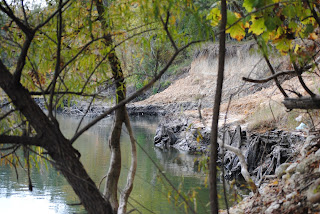 |
| The wooden frame capitol building in Tallahassee as it appeared in 1831 when Ocheesee almost became state capital. State Archives of Florida |
Pensacola and St. Augustine had never been thrilled that the new town being carved from the wilderness had taken their ancient titles as the twin capital cities of Florida. The population boom taking place in in Tallahassee, however, was rapidly solidifying its status.
The 1830 census revealed that Leon County, of which Tallahassee was the county seat, had become Florida's most populous county with 6,494 residents. Gadsden County was next with 4,895 while Jackson County was third with 3,907.
Pensacola and St. Augustine had had lost their centuries old positions as the population centers of Florida in just nine years.
 |
| Florida as it appeared in 1832. (Click to enlarge) |
The delegates met at the tiny frame capitol building in Tallahassee in 1831 and voted for the appointment of a commission to review other potential sites for the establishment of a permanent capital city.
The members of this commission began their work and three places quickly emerged as the leading candidates to replace Tallahassee. They were Ocheesee Bluff in Calhoun County, Mt. Vernon (Chattahoochee) in Gadsden County and an unidentified point on the Suwannee River.
Mt. Vernon, which was soon renamed Chattahoochee due to mail confusion with the Alabama community of the same name, was the only one of these places that had become an actual town by 1831. It had been picked to become the site for Florida's new U.S. Arsenal and the arrival of steamboat traffic on the Apalachicola River spurred its growing development as an important river port.
 |
| The red clay of Ocheesee Bluff in Calhoun County, Florida. |
Interests from the East Coast of Florida favored a location somewhere on the Suwannee River. A city there would have to be built from scratch, but unlike Tallahassee would be closer to St. Augustine, Jacksonville and Fernandina while also offering the advantage of river transportation.
It was a close decision:
SEAT OF GOVERNMENT. - The Commissioners appointed under the Resolution of the last Council have made separate reports - one infavor of Mount Vernon - two infavor of Ocheesee and one infavor of a point on the Suwanee as the seat of Government. - (Tallahassee Floridian, January 10, 1832).
 |
| This historic live oak tree at Ocheesee Bluff survives from the days of the town of Ocheesee, Florida. |
Unable to break this deadlock, the Council delegates themselves decided to wait another year or two and see what might happen:
...The public buildings at Tallahassee will answer, until the progressive improvement of the Country shall show what point is likely to continue central, as regards the population of the Territory. - There are immense bodies of unexplored land of good quality in East Florida, and the Suwanee will probably be the center of population within ten years. - (Tallahassee Floridian, January 10, 1832).
 |
| The restored gunpowder magazine of the U.S. Arsenal at Chattahoochee is now the Apalachicola Arsenal Museum. |
Ocheesee lost its chance to become capital of Florida by a single vote. Had the Apalachicola River supports on the commission unified their votes, the state capitol building would likely be there today. Instead, it is a ghost town. An old oak tree at Ocheesee Landing and the historic Gregory House across the river in Torreya State Park are virtually all that remain to prove it ever existed.
Columbus, the town that soon grew on the Suwannee River, is also a ghost town today. Its cemetery and a few other traces can be seen at Suwannee River State Park.
Chattahoochee still survives as a small but charming city of just under 4,000 people. Its trail system has been named one of the finest of any small town in America and the Apalachicola River is both a Florida Blueway and a National Scenic Trail.
Tallahassee remains the state capital of Florida.
You can learn more about the ghost town of Ocheesee and Chattahoochee's historic River Landing Park in these videos from TwoEgg.TV:
No comments:
Post a Comment